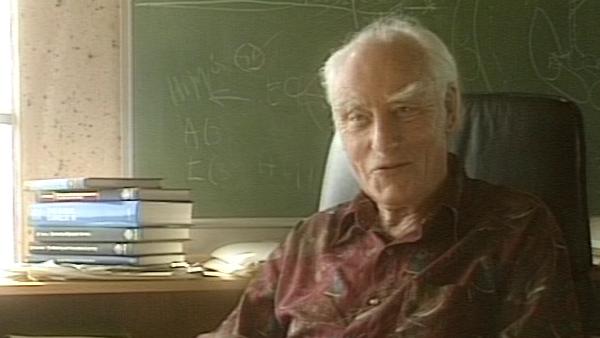NEXT STORY

Treating our research results with caution
RELATED STORIES

NEXT STORY

Treating our research results with caution
RELATED STORIES


|
Views | Duration | |
|---|---|---|---|
| 31. The two areas of biology I chose to work in | 856 | 01:57 | |
| 32. Social interactions among scientists | 947 | 03:06 | |
| 33. Molecular biology in the late 1940s | 1198 | 03:08 | |
| 34. The road to Cambridge | 1241 | 02:16 | |
| 35. James Watson - the bald American | 2094 | 01:25 | |
| 36. James Watson - precocious and fun | 1748 | 01:51 | |
| 37. Treating our research results with caution | 1259 | 00:55 | |
| 38. The triplet code | 1 | 1275 | 00:44 |
| 39. The difficulties solving scientific problems | 1274 | 01:06 | |
| 40. The emotional ups and downs of scientific research | 1379 | 01:10 |


I think he did seem in a hurry. Well, he was young because he was very precocious, he went to the University of Chicago when he was 15, you see, so that’s why he was… he’d got… he’d already got his PhD and had done one year post-doc when he came to us and he was 23. Usually, that’s the stage at which people are… are still working on their PhD. He was a couple of years ahead, roughly speaking, and he was young, but he was obviously very bright. I mean, you know, you could tell that just talking to him straight away. And, the fact that he had a strange manner… we were used to that sort of thing in Cambridge so it didn’t strike you as particularly odd, whereas it probably would strike you as odd… it would strike people as odd in more conventional places.
[Q] I didn’t know… I mean, I didn’t know about his manner.
Well, you know, he speaks… he speaks in a funny way and he is apt to express himself rather… his mind rather freely and a few things like that. These are some of the things you’ve got to get… expect with bright young men in places like Oxford and Cambridge. I mean, there are bright people who are perfectly normal and well adjusted but they don’t always give that impression, I mean, many of them.
[Q] Was it all good fun, I mean, I suppose that’s what I mean?
Oh, well, yes, it was, except, of course, I had to work for a PhD, remember. That… that was… that was interesting but was less fun, I would say. Yes, talking to Jim was always fun and… and, of course, the protein structure work was interesting too. One shouldn't… shouldn’t play that down but… you must remember when we were interested in DNA we didn’t know the structure was going to turn out to be so significant. In fact, Jim said we… we used to wonder whether it was going to be rather dull and all right, we’ll get the structure, what's it going to tell you? You see. But, fortunately it wasn’t like that.
The late Francis Crick, one of Britain's most famous scientists, won the Nobel Prize in Physiology or Medicine in 1962. He is best known for his discovery, jointly with James Watson and Maurice Wilkins, of the double helix structure of DNA, though he also made important contributions in understanding the genetic code and was exploring the basis of consciousness in the years leading up to his death in 2004.
Title: James Watson - precocious and fun
Listeners: Christopher Sykes
Christopher Sykes is an independent documentary producer who has made a number of films about science and scientists for BBC TV, Channel Four, and PBS.
Tags: University of Chicago, Cambridge University, Oxford University, James Watson
Duration: 1 minute, 51 seconds
Date story recorded: 1993
Date story went live: 24 January 2008